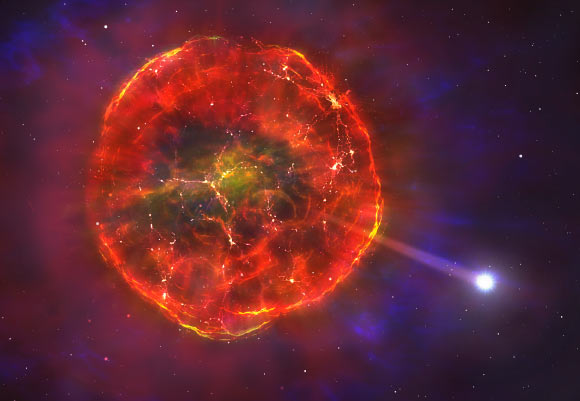A white dwarf star called SDSS J124043.01+671034.68 (SDSS J1240+6710) is traveling at 900,000 km/h (559,234 mph) through our Milky Way Galaxy. It also has a particularly low mass for a white dwarf — only 40% the mass of our Sun — which would be consistent with the loss of mass from a partial supernova. According to new research, SDSS J1240+6710 was most likely a member of a binary system that survived a so-called thermonuclear supernova event, which sent it and its companion flying through the Milky Way in opposite directions.
Source: Sci News
White dwarfs are the remaining cores of red giants after these huge stars have died and shed their outer layers, cooling over the course of billions of years.
The majority of white dwarfs have atmospheres composed almost entirely of hydrogen or helium, with occasional evidence of carbon or oxygen dredged up from the star’s core.
SDSS J1240+6710, which was discovered in 2015, lies 1,432 light-years away from us in the constellation of Draco.
Also known as WD 1238+674 and LSPM J1240+6710, the star was previously found to have an oxygen-dominated atmosphere with significant traces of neon, magnesium, and silicon.
“This star is unique because it has all the key features of a white dwarf but it has this very high velocity and unusual abundances that make no sense when combined with its low mass,” said University of Warwick’s Professor Boris Gaensicke, lead author of the study.
Using the Cosmic Origin Spectrograph onboard the NASA/ESA Hubble Space Telescope, Professor Gaensicke and colleagues identified carbon, sodium, and aluminum in the atmosphere of SDSS J1240+6710, all of which are produced in the first thermonuclear reactions of a supernova.
However, there is a clear absence of what is known as the ‘iron group’ of elements, iron, nickel, chromium and manganese.
These heavier elements are normally cooked up from the lighter ones, and make up the defining features of thermonuclear supernovae.
The lack of iron group elements in SDSSJ1240+6710 suggests that the star only went through a partial supernova before the nuclear burning died out.
“The white dwarf has a chemical composition which is the fingerprint of nuclear burning, a low mass and a very high velocity: all of these facts imply that it must have come from some kind of close binary system and it must have undergone thermonuclear ignition,” Professor Gaensicke said.
“It would have been a type of supernova, but of a kind that that we haven’t seen before.”
The authors theorize that the supernova disrupted the white dwarf’s orbit with its partner star when it very abruptly ejected a large proportion of its mass.
Both stars would have been carried off in opposite directions at their orbital velocities in a kind of slingshot maneuver. That would account for the star’s high velocity.
“If it was a tight binary and it underwent thermonuclear ignition, ejecting quite a lot of its mass, you have the conditions to produce a low mass white dwarf and have it fly away with its orbital velocity,” Professor Gaensicke said.
The best studied thermonuclear supernovae are the Type Ia. But there is growing evidence that thermonuclear supernovae can happen under very different conditions.
SDSSJ1240+6710 may be the survivor of a type of supernova that hasn’t yet been caught in the act.
Without the radioactive nickel that powers the long-lasting afterglow of the Type Ia supernovae, the explosion that sent SDSS1240+6710 hurtling across our Galaxy would have been a brief flash of light that would have been difficult to discover.
“The study of thermonuclear supernovae is a huge field and there’s a vast amount of observational effort into finding supernovae in other galaxies,” Professor Gaensicke said.
“The difficulty is that you see the star when it explodes but it’s very difficult to know the properties of the star before it exploded.”
“The fact that such a low mass white dwarf went through carbon burning is a testimony of the effects of interacting binary evolution and its effect on the chemical evolution of the Universe,” said senior author Professor S.O. Kepler, an astronomer at the Universidade Federal do Rio Grande do Sul.
“Once again, the synergy between very precise Gaia astrometry and spectroscopic analysis have helped to constrain the striking properties of a unique white dwarf, which probably formed in a thermonuclear supernova and was ejected at high velocity as consequence of the explosion,” said co-author Dr. Roberto Raddi, an astronomer at the Universitat Politècnica de Catalunya.
The team’s paper was published in the Monthly Notices of the Royal Astronomical Society.
Source: Sci News

































Leave a Comment
You must be logged in to post a comment.